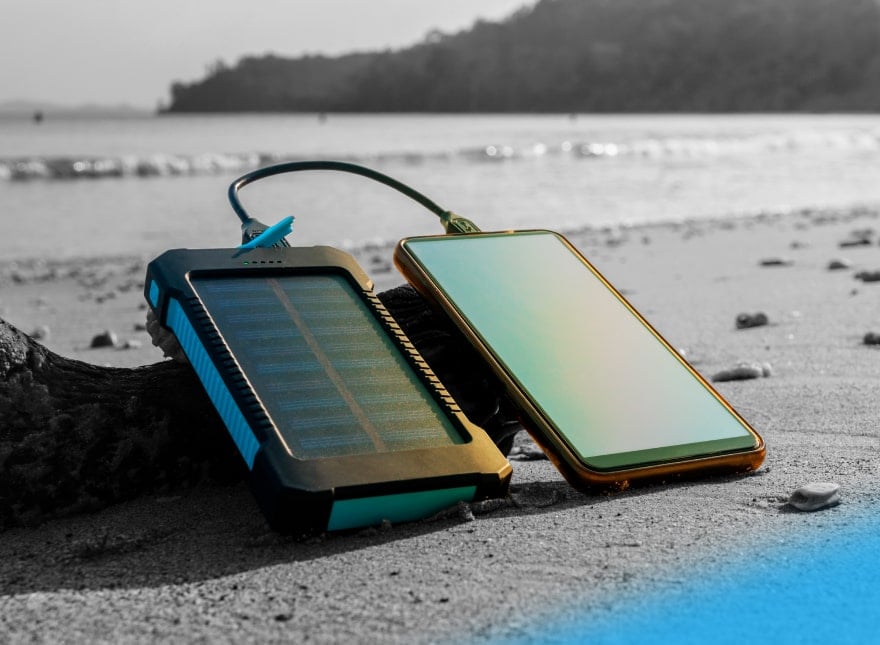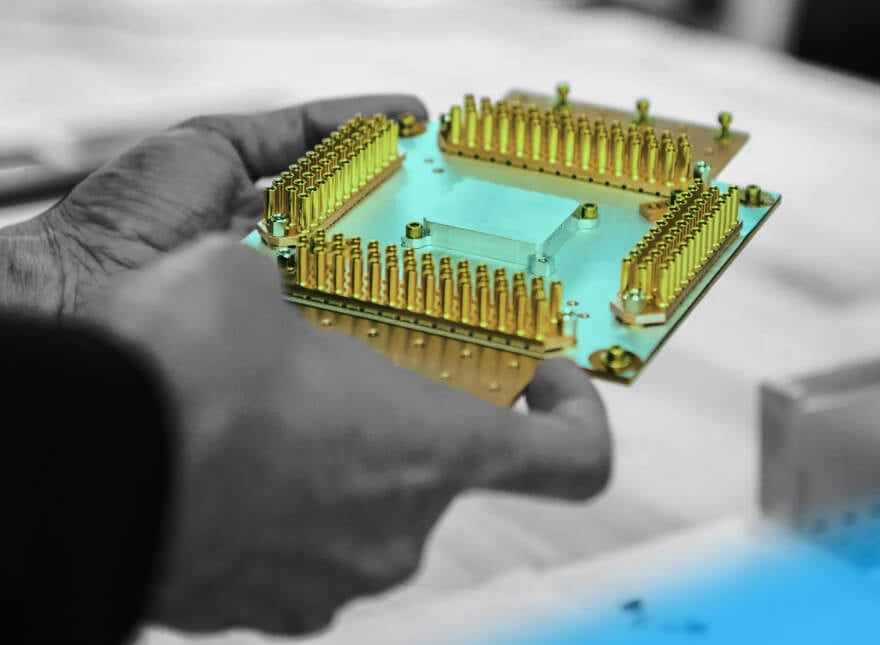The Pet Tech market is booming, and for good reason. Over the last few years, we’ve seen growth in pet ownership among all generations, most of all among 25-40 year-olds, or millennials. Today nearly every third pet owner belongs to this age group. This hugely impacts the entire market.
Millennials bring their usual habits into their relations with animal companions. First, they tend to use gadgets and virtual services to keep their pets safe, secure, and happy. Second, they’re ready to pay for all this as the income of this age group is usually above average. That’s why successful pet devices and healthcare platforms are extremely profitable. Our 2021 infographic on televet care shows huge budgets in the virtual veterinary market. The same is true for the other segments, including pet wearables, connected projects for cats and dogs, and pet video monitoring products.
In our blog post, we’ll talk about the most recent Pet Tech trends. Then we’ll move on to the most popular projects from pet tech startups and provide some insight into their success.
Pet Tech Trends—Looking for Customer’s Needs
The US has always played a leading role in innovations in the Pet Tech market. Despite the economic pain associated with COVID-19, the pandemic has only intensified investments in the sector.
Here is what we see today:
- The number of households with a pet is growing non-stop. During the early part of the pandemic, we saw a wave of cats and dogs adopted from shelters. Since then, the trend continued to rise: 70% of US households have a pet in 2022, which is a jump from 2021 (67%).
- Americans are still splurging for their pets. Inflation and rising prices don't stop them. Every second pet owner is willing to pay more for certain product categories. Those include ethically sourced and eco-friendly ones.
- Millennials make up the most significant group of pet owners. One out of three 25-40-year-old millennials has a pet. They choose to adopt “fur babies” and treat their cats and dogs with extreme care, ready to invest in the best quality food, goods, and services.
- The new generation of pet owners like tech. That’s why pet tech startups are eager to introduce new types of tracking and online communication into their products and services.
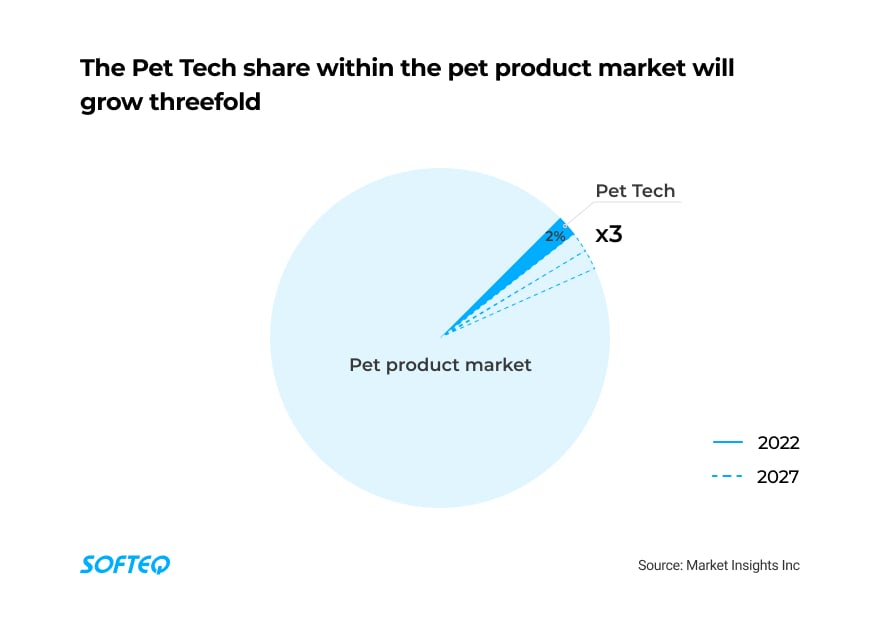
Today’s pet products are more closely replicating the spending on human products. So how do pet owners use technology?
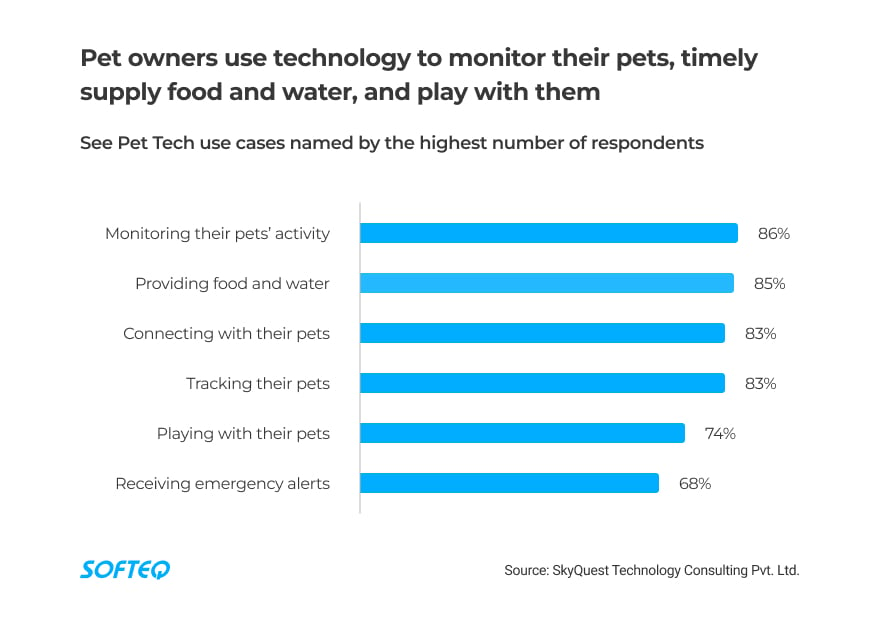
Growing customer interest leads to higher investment into the market. Today tech service providers receive more requests for Pet Tech projects than ever.
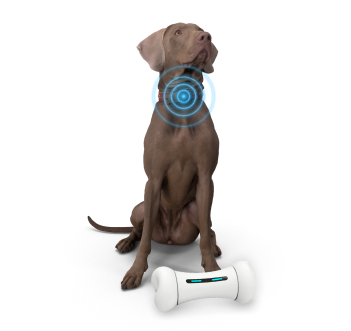
Let’s talk about the four major product groups in the market and look at some real-life success stories.
I. Connected Pet Products
This category includes a variety of products, from smart pet doors to dog fences and toys.
1. PupPod Interactive Dog Game
This multi-level interactive toy offers an ideal combination of elements to train a dog and keep it motivated and active.
The solution consists of several interconnected elements:
- A PupPod device. It’s a puzzle toy that keeps the pet entertained and provides physical activity and mental stimulation
- A feeder tosses a treat once the dog earns its reward. It features an inserted HD camera and live-streaming functionality
- A mobile app to control a game session from anywhere
Be the first to apply smart tech for pets to solve mundane tasks. PupPod was among the pioneers that converged an ordinary product and smart pet toy development. The customer’s problem was the impossibility of playing fetch with their dog 24/7. PupPod offered a tech-based solution. Those who are the first to use advanced technologies have all the chances of winning customers.
2. PetSafe Containment System
Cats and dogs are curious creatures, and owners need to take measures to avoid their little ones running away. But no one wants to turn their home and yard into a prison with wires installed along a fence.
GPS pet fences like the PetSafe product can be the right solution. Usually, this includes the following components:
- A boundary called a radio fence or a wireless fence. It presents a portable transmitter used to define the pet area
- A pet’s collar with a receiver that gets signals from the transmitter
- Alerts to the pet, be it a sound or vibration transmitted to the collar
When a pet tries to go beyond the safety zone, the collar emits a wireless signal that discourages the pet from crossing the safety zone. Wireless fences are both effective and safe. For example, a 2016 University of Lincoln study showed that electronic containment systems don’t affect the welfare or anxiety of cats.
When designing a pet tech solution, consider both pet owners’ needs and pet comfort. Roaming dogs and cats are a big challenge. Smart pet fence software solutions like PetSafe solve the challenge elegantly and securely, without turning a house into a cage for either domestic animals or their owners.
3. Robot Automatic Self-Cleaning Litter Box
One of the most annoying pet care tasks is cleaning a litter box. Luckily, smart cat litter boxes can tackle this unpleasant chore.
Automatic self-cleaning products detect when a cat has used them and do the cleaning. Although there are multiple options on the market, their logic is pretty much the same:
- The litter box includes sensors that detect when a cat has used the box and when it leaves
- An electric motor is another component. It activates the cleaning mechanism.
- After the cat leaves the box, the smart litter box starts the cleaning cycle. In the case of the Litter Robot solution, the motors rotate to sift out the clumps and then scoop them into a receptacle below it. Once filled, the receptacle closes, containing the odors and clumps. Other litter boxes may use automatic rakes or special granules
- A Wi-Fi mobile app allows the cat owner to monitor the cat’s bathroom habits and the level of waste in the receptacle
Define the most annoying and unpleasant troubles of your customers—and offer an easy-to-use innovative IoT Pet Tech solution. Every cat owner would be grateful for an effective smart cat litter box solution to eliminate the need for daily scooping.
4. Sureflap Smart Pet Door
Traditional pet doors often cause trouble:
- Unwanted guests may enter the house
- Pets may be afraid to push their head up against the door
- Other animals may be hard to lock out (or in) after a pet uses the door
Smart pet doors eliminate these risks. These devices typically use an RFID component, whether a pet’s embedded microchip or a tag in a smart collar. A smart pet door receives a signal from the component and recognizes the pet’s presence. As the pet approaches, the system opens the door and automatically locks it after the pet enters.
Additional features vary by model and make. For example, Sureflap models may include:
- Custom Connect Hub app to control the smart door from the phone
- Selective entry/exit, in case a pet owner has several pets, and not all of them are allowed to leave the house
- Timer control to lock/unlock the door at a specified time automatically
- Integrated draft excluders, to leave cold out and heat in or vice versa
When exploring new opportunities, go beyond standards. A basic smart pet door development project uses connectivity technologies to create more secure pet doors. Its functionality can get broader, depending on your Pet Tech product concept. For example, an IoT software development company can integrate Google Home and Alexa. Or, it can add voice control features or a remote app control.
II. Pet Wearables
Today, wearable devices for pets deal with a wide variety of tasks:
- Track and monitor pets
- Send notifications to their owner
- Collect vitals
- Provide necessary information for vets
- Here are some of the most successful examples on the market
5. Wagz Smart Dog Collar
Wearable tech for pets allows manufacturers to add many new functions to a traditional pet accessory such as a collar. High-tech GPS dog collars software solutions rely on built-in sensors. They provide 24/7 monitoring of a pet’s health. Also, they serve as a fitness tracker for domestic animals and help find them if they run off or otherwise get lost.
Smart dog collars are an extremely popular product in the pet wearable market. By 2026, analysts expect the global GPS pet collar market to reach nearly $654 million.
The Wagz smart pet collar is a great example of a device to track and control the pet wearing it. Along with traditional functions, like an embedded GPS module and a step counter, the solution features:
- A built-in microphone to issue voice commands remotely
- A camera mounted on the collar for live video streaming
- A geofence setting, allowing pet owners to define a virtual fence and receive alerts once a dog exits the defined zone
- A barking detection algorithm to detect dog emotions
Add extra value. Add-ons are important for a product to stand out in a competitive market. To get fast feedback from the market, you can outsource building MVPs to an external software development team. Their diverse tech skills may cover all product development stages, from R&D analysis to device design and mobile app development.
6. Inupathy Smart Harness
Usually, developing a smart dog harness means adding GPS to a dog’s harness to detect the dog’s location. There are a variety of such devices on the market right now—but the Inupathy solution clearly stands out.
The product features a heart rate sensor installed in the dog’s belt. It catches signals and translates them into the dog’s emotional state. Each emotion has its color displayed on the harness and in the mobile app, so the dog owner can understand how the pet is feeling right now.
When competition is tough, think about a twist to attract your target audience. A real-time pet tracking solution is a popular function offered by multiple pet tech product manufacturers. But additional functionality, like a focus on the dog’s mental state, is both original and attractive for dog lovers.
III. Pet Healthcare at Home
We have already zoomed in on health tech for pets in this article about pet care on the blog. Make no bones about it—the televet market is booming. Let’s go beyond well-known facts and see how leaders get their slice of the market.
7. VetNOW Pet Telemedicine Platform
The VetNOW platform is one of the most popular solutions on the market for pet care services. It ensures real-time telecommunication between vets and pet owners. Also, it provides:
- High-definition technology for virtual pet examination and teleconsulting
- Seamless integration with other veterinary products and professional applications
- Advanced medical data management, with safe storage and secure role-based sharing
- Vet clinic workflow management tools: virtual booking, appointment notifications, survey tools
Don’t solve a single task—think broader. The platform serves veterinary specialists as well as pet owners. The pet telemedicine solution is more than just a web platform and mobile app used for making video calls. It’s a televet software ecosystem aimed at totally changing vet services as we know them.
8. Orivet Pet DNA Tests
Orivet is a worldwide leader in pet DNA testing. Such tests provide insight into a pet’s breed or breeds. Customers can learn this way about their pet’s special needs and potential genetic diseases.
Traditionally, such test kits contain a self-addressed envelope and a swab to collect a pet’s sample. Then laboratories process the sample and send back the results.
Orivet has gone a step further and decided on custom pet care app development. The application provides all the DNA information discovered thanks to Orivet. Also, it contains useful data on different breeds and other tips for pet parents. The app has quickly become a popular feature that helps the product stand out in the competitive genetic testing market.
Technology adds new perks to a popular product. Think about new ways mobile apps, RFID tags, or other innovations can promote your brand. As we have mentioned, the new generation of pet owners loves everything connected and smart.
IV. Pet-Associated Video Platforms
On-demand pet care platforms focus on every aspect of pet ownership. These can range from video monitoring solutions to social media channels.
9. Petcube Video Platform
Video streaming is an integral part of multi-purpose platforms for pets. Such platforms rely on pet cameras which provide more than high-quality video or two-way audio. First, a pet camera should feature night vision and motion tracking, as well as quickly swivel a full 360° and withstand pet attacks in case they decide to play with it or chew it. Second, it should easily connect to a mobile app and stay controllable from anywhere. Third, pet cameras often feature built-ins: a pet treat dispenser, a laser pointer, and a bark alert sent to the mobile app when the camera detects barking.
One of the pet monitoring solutions is Petcube. The product solves a simple need—when a pet owner leaves their beloved furry friend, they want to see their pet no less than a family member.
The Petcube inventors decided to solve this problem with a pet welfare monitoring solution. They started with a Wi-Fi pet camera connected to the smartphone app. The pet owner can walk with, talk to, and watch the pet no matter the distance between them. Since its launch, the company has delivered several new pet camera models, including models with a treat dispenser, interactive laser toy, and built-in vet chat.
Even if your product description looks simple—develop the best product you can, and it will pay off. Another smart home device, designed solely for communication with pets, may seem redundant. But the Petcube product received $500,000 during its Kickstarter campaign. Later, Petcube got $14 million in seed funding. The reason is the promise of the best quality cameras tailored to pets. Those feature clear night vision, two-way audio to let the pet hear the master’s voice, a wide-angle view to track any animal's movement, and so on.
It might be hard to compete for attention with all the latest consumer gadgets boosted by billions of marketing dollars. But every happy pet parent with a Petcube proves us it’s worth it.
10. The Dodo Pet-Focused Media Platform
The Dodo website was launched in 2014 by a student Izzie Lerer as a hobby. It soon became the leading platform for pet-related videos across Facebook, YouTube, and TikTok. Group Nine Media took care of the Dodo and started widening its audience. Now the platform has 115 million followers and is managed by Vox Media.
Having a loyal community has allowed the Dodo to enrich its offering with other products. Thus the company launched pet insurance and started retail collaborations.
In the Pet Tech segment, the Dodo released Fetch Forward, an online platform focusing on predictive pet healthcare. The solution uses historical data on over 750,000 dogs to generate insights on pet health at all life stages. Pet owners of more than 500 breeds can benefit from this product and better manage the health risks of their pets in the short and long term.
Build and wield a strong brand to expand. Once you create a network of loyal users around your company and your product, max it out. You have the most valuable asset—your customers’ trust. It makes moving beyond traditional boundaries way easier than for new entrants..
Key Takeaways
At the end of 2022, the field of pet-related app development looks quite fruitful. The industry is opening perspectives for products and services of all sorts. If you are working on a Pet Tech product idea, Softeq is ready to design, prototype, and manufacture it.
More articles on the topic

